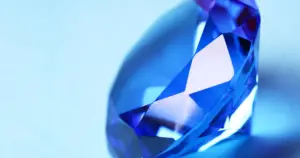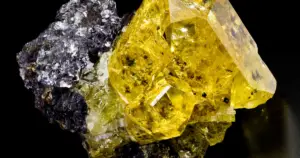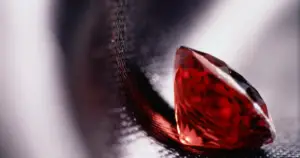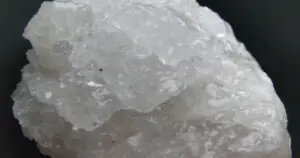Microcline Meaning: Healing Properties, Benefits and Uses
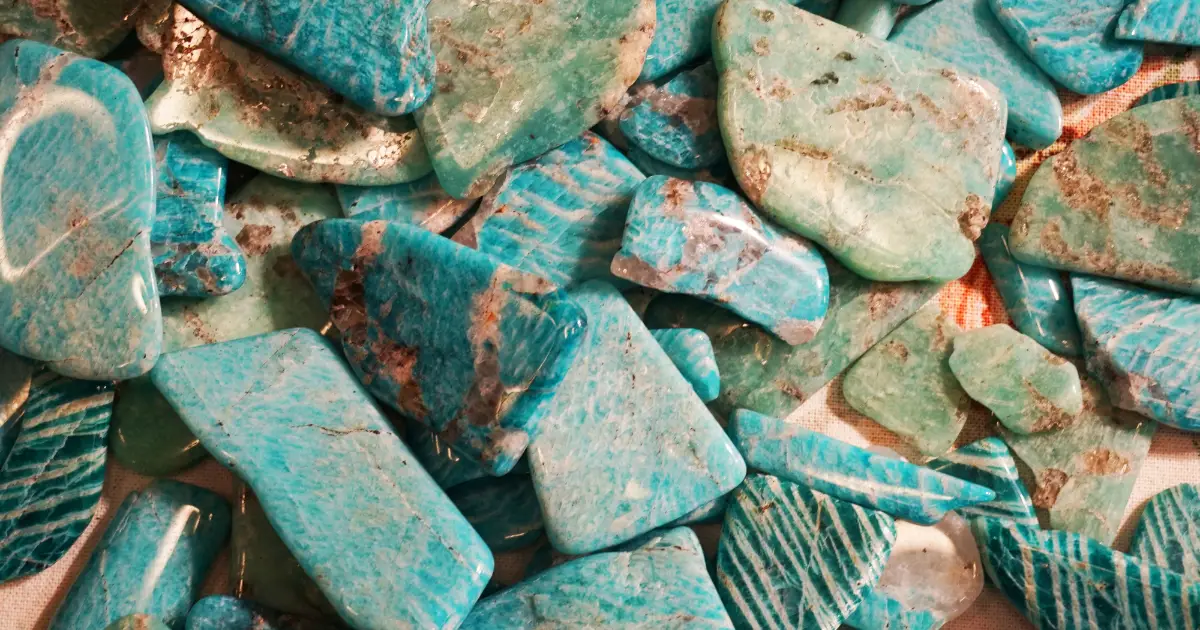
Table of Contents
What is Microcline?
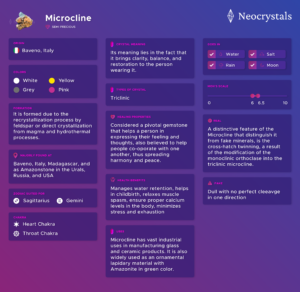
Microcline is an igneous rock-forming tectosilicate mineral that is a potassium-rich alkali feldspar. It is one of the most common feldspar minerals found in various colors like white, cream yellow, salmon pink, red, blue-green, and more. It is a rock-forming mineral found in different types of rocks like granite, syenite, and pegmatite.
It belongs to the triclinic crystal system and has a prism angle that is slightly less than the right angle. The chemical compound name of Microcline is potassium aluminum silicate. There are wide varieties of Microcline available worldwide like- Amazonite, Chesterlite, Ferruginous Microcline, Hyalophane, and Perthite.
How to Identify a Microcline?
One of the distinctive features of Microcline that makes its identification an easy process is the cross-hatch twinning which is formed as a result of the transformation of the monoclinic orthoclase into triclinic microcline. When one set of parallel plane twins intersects with one another at an angle of 90 degrees, it results in the formation of a pattern called cross-hatch.
Since it is a diagnostic characteristic of the Microcline, this is also referred to as Microcline twinning. You can also identify the Microcline by its blocky rectangular shape where two cleavages form at the 90-degree angle.
– Microcline Cuts
Amazonite, one of the Microcline types is typically cut en cabochon, which means the gemstone is cut with a convex round surface that is polished but unfaceted. This displays an emphasis on its luster and color. But there is also faceted microcline that adds texture and depth to the appearance of the Amazonite.
Since it is found in large deposits, cutting large gems of Microcline from a rough specimen is relatively easy. Celestite, another form of Microcline that is relatively ahead to cut is very rarely seen in gem collections. Whether it is rough or uncut, Microcline is widely available for purchase due to its affordability.
– Microcline Shapes
Microcline can be faceted into any shape- round, oval, square, or pear. It is the hardness and the abundance of Microcline that makes it suitable for manufacturing figuring and carvings. It is generally opaque to transparent, however, you will seldom find a transparent Microcline.
You will find a polished Microcline with a wet waxy luster that makes it appealing. Its clarity varies from gemstone to gemstone. You may find Microcline with white threads and occasional dark spots as its inclusion.
Where is Microcline Found?
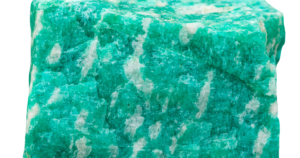
Microcline is found in granite pegmatites and metamorphic rocks such as gneisses, and schists. Microclines can be massive and are generally found in feldspar-rich rocks like granite, syenite, and granodiorite. It is abundantly found in Baveno, Italy, Kragero, Nor, and Madagascar. As an amazonstone, Microcline is available in the Urals, Russia, and Florissant, Colo, US.
Microcline Stone Meaning
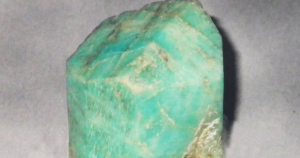
Microcline is considered a powerful healing stone that aids in the physical, mental, emotional, and spiritual well-being of a person. Its meaning lies in the fact that it brings clarity, balance, and restoration to the person wearing it. It is widely popular for stimulating clarity of thought and helps people by enhancing their understanding to make clear decisions. It is considered a pivotal gemstone that helps a person in expressing their feeling and thoughts. It is also believed to help people corporate with one another, thus spreading harmony and peace.
– Microcline Meaning in Ancient Lore and History
Microcline gets its name from the Greek terms Mikron meaning little and klinein meaning incline. Although it is not associated with any zodiac sign, in particular, it is believed to have a special association with the Libra in astrology. It was discovered in 1830 by a German mineralogist Johann Friedrich August Breithaupt.
The name is credited to it being discovered on the Norway naval base. While it has become a mainstream mineral today, Mircocline in the earlier days was only used in Ancient Egypt and Mesopotamia for jewelry and ornamentation. Kind Tut’s tomb has traces of beaded amazonite in it. Today it is mostly used in the manufacturing of porcelain wherein it is first grounded and blended with a type of clay and quartz. It is then heated to form a cement-binding material. It is also sometimes used to supply alumina during the process of manufacturing glass.
Microcline Crystal properties
Despite being popular for manufacturing glass, amazonite, a type of Microcline is considered a favorite amongst gem collectors. Amazonite is widely available in various colors due to the presence of lead and water existing within the stone. You will find Microcline in colors like light green, yellow-green, bright green, and vivid blue-green.
It displays a distinct reflective index and has veins in the color of white streaks and marble which range in intensity. The value of a Microcline increases with the decreasing white streaks which means the more white, the less it will be its value.
Microcline Healing Properties
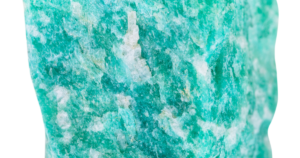
Microcline is a holistic healing stone that is believed to assist in the physical, mental, and emotional well-being of a person. People struggling with eye disorders and fever should use MIcrocline as it helps ease the symptoms and relieves the body from pain. Women who are about to undergo childbirth should also make use of Microcline as it is believed to help make the process relatively easy.
Microcline also helps relieves the symptoms associated with muscle spasms. People with calcium deficiency should also consider getting Microcline as it is believed to normalize the calcium level in the body. If you are constantly burdened with stress and exhaustion, Microcline can help minimize it. Since it calms down a person by soothing their nerves, Microcline is especially helpful for people struggling with anxiety.
Microcline Metaphysical Properties
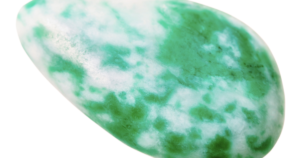
Microcline is believed to help people think clearly and it also enhances understanding. Since it is believed to help people express their feeling and thoughts more confidently, it also helps them make the right and informed choice. It is also believed to bring chakral balance to the body. The deeper the color, the more intense will be its powers.
Microcline Benefits
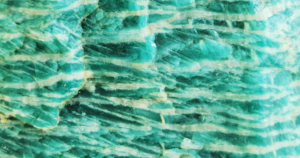
Some of the benefits of Microcline are:
- Manages water retention
- Helps in childbirth
- Relaxes muscle spasm
- Ensure proper calcium levels in the body
- Minimizes stress and exhaustion
Microcline Benefits Spirituality
The microcline helps to flow the energy with clarity and balance. It is believed to help people struggling with anxiety and depression. It works wonders in restoring the energy of the mind, body, and soul. It is said to be especially helpful in speeding up the process of recovery and rejuvenation. It helps in stimulating the heart chakra thereby helping the person overcome external pressure and find peace in acceptance.
Since Microcline also stimulates the throat chakras, it helps the person regain the confidence to express their thoughts and feeling and find their voice. Microcline is also used to attain a higher connection with your spiritual self, thereby promoting better understanding and self-care.
To know the other best crystals for the throat chakra, read here.
Microcline & Feng Shui
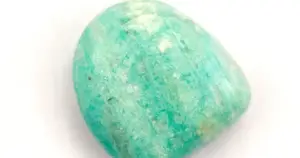
Feng Shui is a Chinese traditional practice that involves arranging objects, houses, and buildings in a way that brings balance, harmony, and peace within oneself and the surrounding. It is a symbol of a form of self-care wherein it is believed that once you change your perspective about your environment, you will be able to change the way you behave and react to situations. This helps in aligning your throughs and actions in a supportive manner.
Since Microcline helps brings clarity to thoughts and stimulate better understanding, we would recommend placing them in your area of work to help you make the right decision and boost productivity.
It also helps the person by boosting their confidence and giving them the power to express themselves in a better way. If you are someone who has to address large public on regular basis, we recommend putting Microcline in your pocket to help you express yourself more freely.
Microcline Birthstone
Microcline is a common mineral but not very well known and it is used as a semi-precious stone under the name Amazonite or Perthite. The Amazonite variety is an alternative for the December birthstone. Perthite on the other hand is considered to be an alternate for June birthstone.
December birthstone is considered to be a love charm, which means it is considered a potent gemstone in attracting whom you desire. In ancient societies, December birthstones were also considered a symbol of wealth, prosperity, and abundance. It also exhibits characteristics like sensitivity, strength, protection from the evil eye, good fortune, kinship, and peace. Furthermore, it is also believed to help a person achieve a higher connection with the spiritual realm. It is also considered to be a symbol of integrity, chastity, dignity, and purity.
The June birthstones are believed to help people dealing with marital problems by encouraging them to achieve a stable marriage. It is believed to be associated with chastity and modesty. Furthermore, June’s birthstone is also believed to be related to learning and concentration.
It is said that it can enhance intuition, enrich creativity and help a person become more creative by sparking their imagination and helping bring good vibrations to the person wearing it. It is also closely associated with the mystery and magic of the lunar and is believed to have soothing and stabilizing energy that can align with the natural biological rhythm. Being an ultimate fertility stone, it is also said to spark passion in new lovers as well as reignite old love. Furthermore, it is also believed to help travelers go out at night.
Microcline Chakras
Different variety of microcline is associated with different chakras but mainly microcline help aligns and heals the heart chakra. All the emotional energy flows through the heart chakra and it acts as a beautiful bridge between lowering ground chakras and higher spiritual chakras. Microcline helps instill compassion, love, forgiveness, self-care, empathy, and connection with others. It helps the person let go of the emotional trauma and nurtures them to enjoy deep experiences of life.
A blocked heart chakra means the person will hold a grudge and not forgive others. Microcline helps the person look past the mistakes. It also eases the symptoms of anxiety and depression. People struggling with issues like heart palpitation, high blood pressure, and poor circulation have their heart chakra blocked, which Microcline can help in opening and cleaning. It also helps the person overcome external pressure and gives them the ability to better express themselves.
What are the Uses of Microcline?
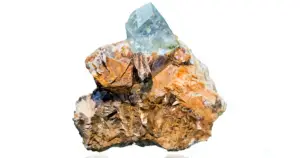
Microcline has vast industrial uses in manufacturing glass and ceramic products. It is also widely used as an ornamental lapidary material with Amazonite in green color. The manufacturing of glass sometimes includes using feldspar along with Microcline. It is also used in the manufacturing of porcelain.
Manufacturers ground it into fine pieces and then mix it with kaolin and quartz. This mixture is then heated and the fumes feldspar is then used as a binding material together. Sometimes the feldspar is also the main constituent in the glaze on porcelain. It is also used to relieve muscle spasms, normalize calcium levels in the body and release stress and exhaustion.
Caring for Microcline
Microcline has a Mohs hardness scale rating ranging between 6 and 6.5, which means it is an extremely durable and sturdy mineral and is not prone to damage by a blade or a knife. But despite all this, we recommend placing microcline jewelry in a velvet pouch and away from other jewelry, preventing scratches and fractures.
– When to Cleanse Microcline?
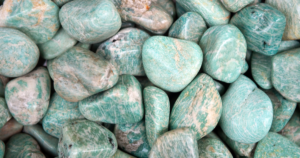
If you plan to gently clean them, we recommend using a soft, lint-free cloth. To give it a thorough clean, you can use mild soap, warm water, and a soft-bristled brush. Avoid using ultrasonic cleaners, harsh chemicals, or detergents. We also recommend keeping it away from places that experience sudden temperature changes, to prevent it from damage.
– How to Recharge Your Microcline?
We recommend recharging the Microcline after every healing session so that all the negative energy that it has absorbed during the healing sessions can be cleaned from it. Furthermore recharging the Microcline ensures that it is back to the condition where it can be used for the next healing session. Charging Some of the best ways to recharge Microcline are:
- Full moon: Full moon is one of the best times to clear and charge your Microcline. Charge your Microcline by putting it in a bowl and placing it under direct moonlight. You can prepare moon water on a full moon night and rinse the Microcline in it.
- Ground: This is one of the best ways to charge your Microcline with all the energy of the ground. Put it in a jar and bury it in the ground for a week for it absorbs all the energetic properties of the ground.
- Incense: It is one of the oldest and most widely used methods of cleansing and recharging Microcline. Burn some herbs like sage, cedar, or incense like sandalwood and pass the crystal through the smoke for about 2-3 minutes.
- Crystal Cluster: You can also use the energy of other crystals and clusters which can energize a Microcline by absorbing and neutralizing the negative energy. One of the most popular crystals which helps in revitalizing other crystals is Selenite. Place your Microcline in a selenite bowl for a few hours to help it get rid of negative energy and recharge it with higher vibrations.
Another highly known method to recharge your Microcline gemstone is by putting it under sunlight. But since this might fade the gemstone, we suggest only doing so for a short time and avoiding placing the gemstone in direct sunlight. Gemstones with shades of pink, purple, green, blue, and black should be kept under the moonlight since they are vulnerable to getting faded in the sunlight.
– Microcline Activation process
Activating Micrcocline is important to ensure that it has all the energy of the sun, moon, and earth required to help the person heal- physically, emotionally, and mentally in the next healing session. We recommend activating your Microcline after every healing session.
Moonlight: Place your Microcline in a bowl and out at a location where there is direct moonlight which can activate the gemstone. We suggest placing the Microcline under the full moon’s light, as this is the time when the light is brightest and this has the potential to increase the stone’s vibrations.
Crystal Grid: A crystal grid is essentially an arrangement wherein the crystals are organized in such a manner with the crystal that is to be activated and placed in the center it can absorb the energy of all the other crystals to reinvigorate itself. Make sure to only place those crystals in the grid whose properties coincide with your intentions.
Prayer: Prayer or meditation are considered to be purposeful interactions. You can activate your Microcline by saying a prayer with honest intention, keeping your mind free from any other thought. The aim is to set your intention by holding the crystal, breathing through it, and connecting with its energy.
How much is Microcline Worth?
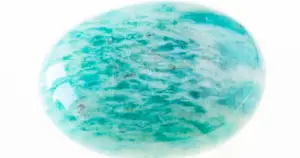
Microcline is priced per carat and their price increases with quality. Typically, a cabochon and faceted microcline costs around $0.26 to 0.40 per carat. Rough, uncut microcline is more affordable with its price ranging anywhere between $0.13 to $0.32 per gram. You can find a high-quality specimen for around $0.87 per gram. The price of the jewelry made from microcline depends on the metal setting that is used and the kind of gem which are added to the jewelry.
Typically, you will find a microcline necklace anywhere between $34 to $150. If you are looking for a luxurious piece, you might have to pay more than $500. Rings made from microcline can range from anywhere between $12 to $1219. One of the most common pieces of jewelry made out of microcline is beaded bracelets which can cost anywhere from $20 to $70. If you are looking for a high-end bracelet you might have to shed a few hundred dollars out of your pocket.
– What determines Microcline’s price and value?
A microcline’s price and value depend on several factors including the density of the streaks and the size of the stone. Amazonite, a blue-green variety of the Microcline contains white streaks with marble-like veining, which can vary in intensity. The fewer the white streaks, the higher would be the price of the gemstone. Furthermore, since the amazonite is priced per carat, the larger would be the stone, the more would be its value.
Microcline Impact
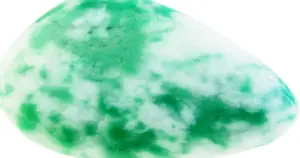
Microcline is a powerful healing stone that helps a body heal- physically, mentally, emotionally, and spiritually. It helps the mind, body, and spirit attain a sense of calmness and clarity, alongside giving way to utmost balance and restoration. It is very useful in helping all the different aspects of the body recover and regenerates.
Microcline is believed to help people by instilling their confidence and enhancing their ability to corporate and collaborate with others. Amazonite, a blue-green variety of Microcline is believed to help a person by calming their emotions and soothing their nerves. It is also said to help people express themselves freely and in a more clear manner.
Does Microcline make a good jewelry stone?
Amazonite and Perthite are a variety of Microcline that is used as a gemstone in jewelry and ornamentation. Amazonite, a green or blue-to-green variety of Microcline is extensively used for cabbing and carving and is used in making jewelry. The presence of lead gives Amazonite its beautiful and deep blue-green colors. Perthite on the other hand has a leopard-like pattern which is caused by the lamellar intergrowths within the crystal. You may find a Perthite with white or clear stripes.
Microcline Real vs Fake
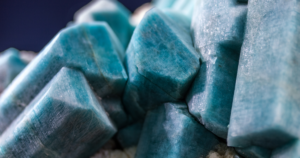
Although Microcline is a common mineral since it is used as a semi-precious stone, many counterfeiters are selling fake Microcline under the name of authentic ones. This is why it is essential to know how can you differentiate between real and fake microcline so that you don’t get duped into purchasing a fake one at the price of an original.
You can identify a Microcline by its color. It is generally available in white, pale yellow, brick-red, green, or clear shades. A distinctive feature of the Microcline that makes distinguishing it from fake minerals, an easy task is the cross-hatch twinning which is a result of the modification of the monoclinic orthoclase into the triclinic microcline. A cross-hatch is a pattern that is formed when one set of parallel plane twins intersects with one another at an angle of 90 degrees.
Summary of Microline
| Name of Crystal | Microcline |
| Precious | No |
| Semi Precious | Yes |
| Other Names | |
| Origin(s) | Baveno, Italy |
| Color(s) | White, grey, yellow, pink |
| Formation | It is formed due to the recrystallization process by feldspar or direct crystallization from magma and hydrothermal processes. |
| Majorly Found at | |
| Zodiac Suited for | December and June |
| Chakra | Heart, throat |
| Crystal Meaning | Its meaning lies in the fact that it brings clarity, balance, and restoration to the person wearing it. |
| Types of Crystal | Microcline is an igneous rock-forming tectosilicate mineral that is a potassium-rich alkali feldspar. |
| Healing Properties | It is considered a pivotal gemstone that helps a person in expressing their feeling and thoughts. It is also believed to help people corporate with one another, thus spreading harmony and peace. |
| Health Benefits | Manages water retention
Helps in childbirth Relaxes muscle spasm Ensure proper calcium levels in the body Minimizes stress and exhaustion |
| Uses | Microcline has vast industrial uses in manufacturing glass and ceramic products. It is also widely used as an ornamental lapidary material with Amazonite in green color. |
| Goes in Water? | Yes |
| Goes in Salt Water? | Yes |
| Goes in Rain Water? | Yes |
| Goes in Moon Water | Yes |
| Moh’s Scale | 6-6.5 |
| Real | A distinctive feature of the Microcline that makes distinguishing it from fake minerals, an easy task is the cross-hatch twinning which is a result of the modification of the monoclinic orthoclase into the triclinic microcline. |
| Fake | Dull with no perfect cleavage in one direction |
FAQs
What is microcline used for?
Microcline is an igneous rock-forming tectosilicate and a potassium-rich feldspar mineral. It can be found in a wide range of colors like white, brown, yellow, pink off-white, and more. Its Mohs scale hardness rating ranges between 6 and 6.5, making it a sturdy and durable material.
Where is microcline found?
It can be found in acidic alkali-rich plutonic rocks in the areas of Pala, California, Maine, New York, North Carolina, Russia, Norway, Sweden, Germany, Italy, Japan, South Arica, and Colorado.
What is the difference between microcline and orthoclase?
Microcline has a highly ordered structure unlike Orthoclase, which exhibits a partially ordered structure. Furthermore, Orythoclase is a high-temperature monoclinic polymorph while microcline displays features of a medium to low-temperature triclinic polymorph.
Is microcline a crystal?
Yes, Microcline is a crystal that belongs to the triclinic crystal system.
What is a microcline made of?
Microcline is a triclinic low-temperature K-feldspar that attains stability at a temperature lower than 500 degrees Celsius. It is formed due to the recrystallization process by feldspar or direct crystallization from magma and hydrothermal processes.
Is microcline quartz?
While Microcline forms crystals in association with quartz, it can be called complete quartz and thus falls in the category of crystals.
How do you identify microcline?
Microcline is defined by their blocky rectangular shape wherein two cleavage planes intersect at 90 degrees. Another distinctive feature that results in the transformation of orthoclase to microcline is the cross-hatch twining.
Why is microcline pink?
It is the admixture of iron in the Microcline which results in its color changing from white to pink or red.
